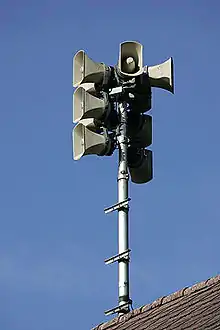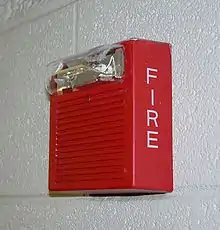Warning system
Warning system is any system of biological or technical nature deployed by an individual or group to inform of a future danger. Its purpose is to enable the deployer of the warning system to prepare for the danger and act accordingly to mitigate or avoid it.



Warnings cannot be effective unless people react to them. People are more likely to ignore a system that regularly produces false warnings (the cry-wolf effect), but reducing the number of false warnings generally also increases the risk of not giving a warning when it is needed.[2] Some warnings are non-specific: for instance, the probability of an earthquake of a certain magnitude in a certain area over the next decade. Such warnings cannot be used to guide short-term precautions such as evacuation. Opportunities to take long-term precautions, such as better building codes and disaster preparedness, may be ignored.[3]

Biological warning systems
- Aposematism (e.g. warning coloration)
- Climate canary
- Fear
- Miner's canary
- Pain
Man-made warning systems
Civilian warning systems

- Alberta Emergency Alert
- Alberta Emergency Public Warning System (replaced by Alberta Emergency Alert)[4]
- Alert Ready (Canada)
- Automatic Warning System
- Child abduction alert system
- Dam safety system
- Earthquake warning system
- Emergency Alert System (EAS) (United States)
- Famine Early Warning Systems Network
- Federal Civil Defense Authority
- Fire alarm system
- Gale warning
- Ground proximity warning system
- Indian Ocean Tsunami Warning System
- International Early Warning Programme
- J-Alert (Japan)
- Lane departure warning system
- National Severe Weather Warning Service
- N.E.A.R. (National Emergency Alarm Repeater)
- North Warning System
- Standard Emergency Warning Signal (Australia)
- Traffic Collision Avoidance System
- Train Protection & Warning System
- Tsunami warning system
Military warning systems
Historical beacon-based systems:
- Byzantine beacon system in Asia Minor during the 9th century
Space-based missile early warning systems:
- Defense Support Program (United States, to be succeeded by the "Space-Based Infrared System")
- Space-Based Infrared System (SBIRS) (United States)
- Oko, also known as "SPRN" (Russia)
Airborne early warning systems:
- Airborne Early Warning and Control ("AWACS" for NATO, many countries have developed their own AEW&C systems)
Ground-based early warning radar systems:
- Ballistic Missile Early Warning System and PAVE PAWS (United States)
- Duga radar, also known as the "Russian Woodpecker" (Russia)
- Dnestr radar (1st generation Russian)
- Daryal radar (2nd generation Russian)
- Voronezh radar (3rd and current generation Russian)
- Chain Home (British, now defunct)
- Chain Home Low (British, now defunct)
- ROTOR (British, now defunct)
Optical sensors:
Emergency broadcasting:
- CONELRAD (United States, succeeded by the Emergency Broadcast System)
- Emergency Broadcast System (EBS) (United States, succeeded by the Emergency Alert System)
See also
Notes and references
- Testing sirens, Swiss Federal Office for Civil Protection (page visited on 7 September 2013).
- Sättele, Martina; Bründl, Michael; Straub, Daniel (October 2015). "Reliability and effectiveness of early warning systems for natural hazards: Concept and application to debris flow warning" (PDF). Reliability Engineering & System Safety. 142: 192–202. doi:10.1016/j.ress.2015.05.003. ISSN 0951-8320. Archived from the original (PDF) on 2018-02-07. Retrieved 2018-02-07.
- "Attempts to predict earthquakes may do more harm than good | Professor David Petley". TheGuardian.com. 30 May 2012.
- Archived December 12, 2006, at the Wayback Machine